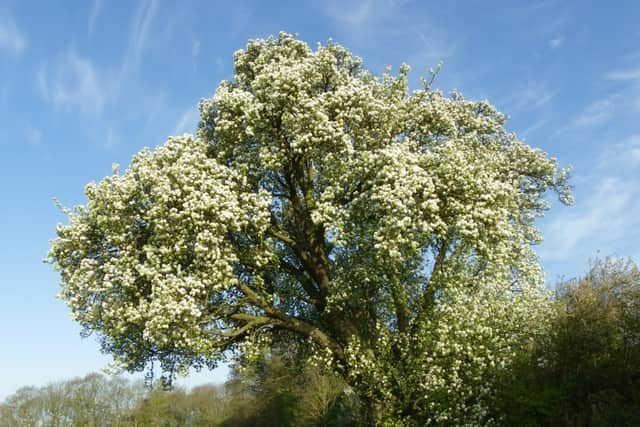Cubbington Pear: 200-year-old tree of the year felled to make way for controversial HS2 is growing back
and live on Freeview channel 276
A 200-year-old pear tree once voted England's best has delighted locals once more, after being controversially felled for the HS2 expansion.
Warwickshire's Cubbington Pear, thought to be one of the biggest pear trees in the UK, was voted the Woodland Trust's English Tree of the Year in 2015 - a prestigious title also held by the illegally-felled Sycamore Gap tree. However, despite huge opposition from locals, it was removed to make way for the the controversial rail line in 2020.
Advertisement
Hide AdAdvertisement
Hide AdBut parts of the tree were salvaged, with the stump and root ball removed by contractors and replanted in a field, about 100 metres from its original home. Several cuttings were also taken and grafted onto new rootstock - with several young trees now returned to the community. Now, to the delight of the locals, the original pear tree stump has begun sprouting new shoots and leaves too.


Penny McGregor, whose family owned the woodland where the HS2 rail line now stands, used to see the tree through her kitchen window every morning. "It was a great shame to see the tree go," Ms McGregor told SWNS. “But its regrowth has been extraordinary to watch and it shows the power of nature - it just needs the right conditions to thrive."
The pear had been "an absolutely cracking tree with a very amazing blossom", she continued. “When HS2 moved the tree they didn’t know [if] it was going to survive, but they did their best to make sure the root ball was moved and so had the chance to potentially live on... We had no idea it would regrow - but I was hopeful.”


Penny admitted the tree was “not in a good state” when it was chopped down, but it now had plenty of shoots which were growing steadily. Because it was not grafted like many other fruit trees, it may some day produce pears again, she said, which although they reportedly didn't taste nice for humans, were “great for bats”.
Advertisement
Hide AdAdvertisement
Hide AdDespite its popularity with locals, the Cubbington Pear was not able to be moved in its entirety back in 2020. A survey of the tree found that the veteran tree was hollow at the base, "therefore translocation is extremely unlikely to be successful and is not proposed".
"If the tree is moved, there will be a change in wind dynamics experienced by its crown which is highly likely to increase the risk of failure, especially with the trunk cavities present," the survey said. "It is concluded that the tree is not suitable for translocation."
Amy Middlemist, Landscape Lead at Balfour Beatty Vinci - which is responsible for the building of HS2 - said: “We’re thrilled that the Cubbington pear tree is living on in its new location, within one of HS2’s thriving new habitats for wildlife." Ms Middlemist said that over the last three years, they had planted 60,000 new trees across 17 hectares of land around South Cubbington Wood, including creating 'green corridors' to connect different parts of the woodland.
"We’ve also created seven new ponds which are attracting swallows and swifts and providing homes for newts, frogs and insects," she cotinued. “We continue to deliver HS2’s ambitious landscape and habitat creation programme in this area, including building two green bridges which will reconnect public footpaths and wildlife corridors.”
Comment Guidelines
National World encourages reader discussion on our stories. User feedback, insights and back-and-forth exchanges add a rich layer of context to reporting. Please review our Community Guidelines before commenting.
